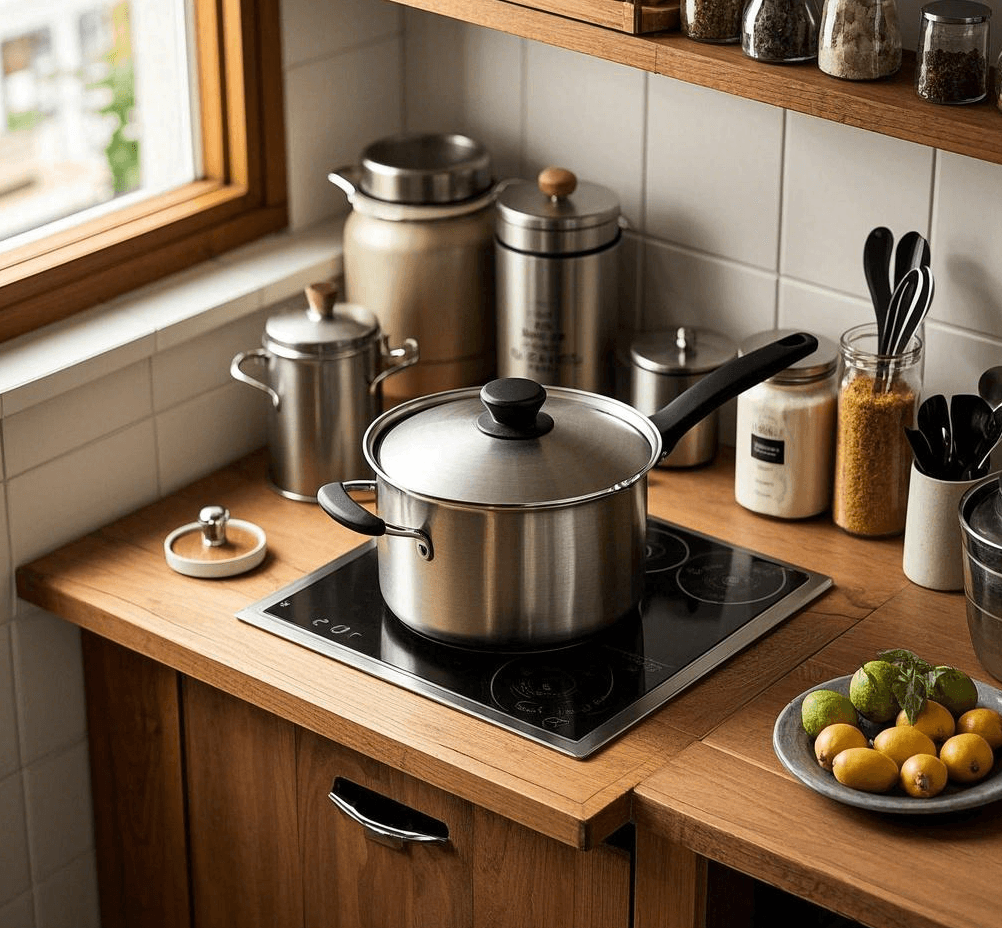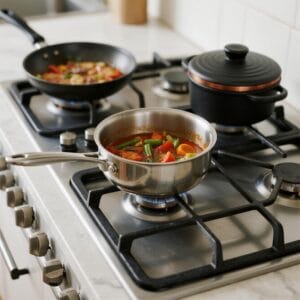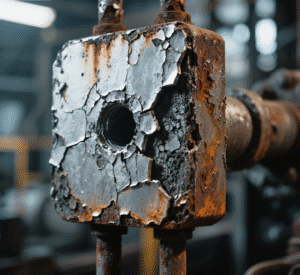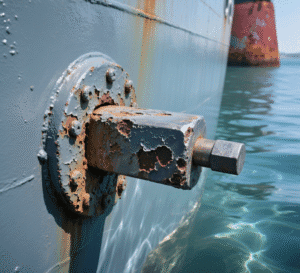Introduction: The Importance of Non-Reactive Cookware
When cooking acidic foods like tomatoes, citrus, or vinegar-based sauces, the material of the cookware can significantly impact both the flavor of the food and its safety. Non-reactive materials, such as stainless steel, are crucial in preventing unwanted chemical reactions between the food and the cookware. But how does the non-reactive nature of stainless steel specifically benefit the cooking process, particularly when working with acidic foods?
The non-reactive nature of stainless steel ensures that no metallic taste or harmful chemicals leach into food, preserving both the flavor and safety of dishes, especially those with acidic ingredients.
Let’s explore the specific benefits of using stainless steel cookware for cooking with acidic foods.
What Does Non-Reactive Mean in Cookware?
A non-reactive material in cookware refers to a material that does not interact with the food during cooking. When cooking acidic foods, some materials can react with the acids, leading to a change in the food’s flavor or even leaching harmful chemicals. Stainless steel, however, is known for its resistance to such reactions.
Key points about non-reactive cookware:
• Doesn’t Leach Metals: Unlike reactive metals, such as aluminum or cast iron, stainless steel does not release metallic particles into food.
• Maintains Food Integrity: Non-reactive cookware preserves the intended flavor, texture, and nutritional value of the food.
This is particularly important for dishes that rely on the natural taste of ingredients, such as tomato-based sauces or citrus desserts.

How Does Stainless Steel Prevent Flavor Alterations?
Acidic foods can often alter the taste of a dish if the cookware reacts with the ingredients. Stainless steel is inherently resistant to corrosion and chemical reactions, meaning it will not impart any metallic taste into the food.
• Acidic Foods: Ingredients like tomatoes, vinegar, and citrus release acids that can cause reactive cookware to leach metals or react with the surface. This can result in a sour, metallic, or off-taste in the food.
• Stainless Steel: The material’s non-reactive surface ensures that the natural flavor profile of acidic foods remains intact, providing a pure, authentic taste.
This characteristic makes stainless steel particularly useful for preparing delicate dishes such as tomato sauces, pickles, or citrus-infused recipes.
How Does Non-Reactivity Contribute to Food Safety?
Food safety is paramount, especially when cooking with ingredients that require precise temperature control, like vinegar or citrus. Some reactive cookware can not only alter the flavor of the food but may also release potentially harmful compounds into the food when exposed to acids for extended periods.
• Stainless Steel: Its resistance to corrosion and leaching makes it one of the safest materials for cooking acidic foods. It does not release any harmful chemicals, even under high heat, ensuring that the food remains safe to eat.
• Reactive Cookware: Materials like aluminum or unlined copper can leach toxic metals or cause chemical reactions, which can be unsafe for both the food and the consumer.
The non-reactive nature of stainless steel gives peace of mind that the food is not contaminated by harmful substances.
How Does Stainless Steel Maintain Cooking Consistency with Acidic Foods?
Acidic foods often require careful cooking to prevent over- or undercooking, which could affect their texture or nutritional value. Stainless steel’s non-reactivity ensures that cooking temperatures remain consistent, as the cookware does not react or alter the cooking process.
• Uniform Heating: Stainless steel provides even heat distribution, essential for cooking acidic foods that need steady, controlled temperatures.
• No Flavor Distortion: As the cookware doesn’t interact with the food, it helps maintain the proper cooking conditions without the risk of changing the color, texture, or taste of the dish.
For dishes like marinara sauce or lemon chicken, this consistency is essential to achieving the desired result.
How Does Stainless Steel Handle Long Cooking Times with Acidic Foods?
Many acidic dishes, such as stews, sauces, and braises, require long cooking times at medium to low heat. Stainless steel’s non-reactive nature is particularly advantageous in these scenarios.
• Long Cooking Durations: Since stainless steel doesn’t react with acidic ingredients over time, you can cook these foods for hours without worrying about flavor changes or harmful leaching.
• Preserving Nutrients: Unlike reactive metals, which may degrade over extended cooking periods, stainless steel preserves both the nutrients and flavor of the food throughout the process.
This makes stainless steel ideal for slow-cooked, acidic dishes such as slow-simmered tomato sauces, curries, or pickling.
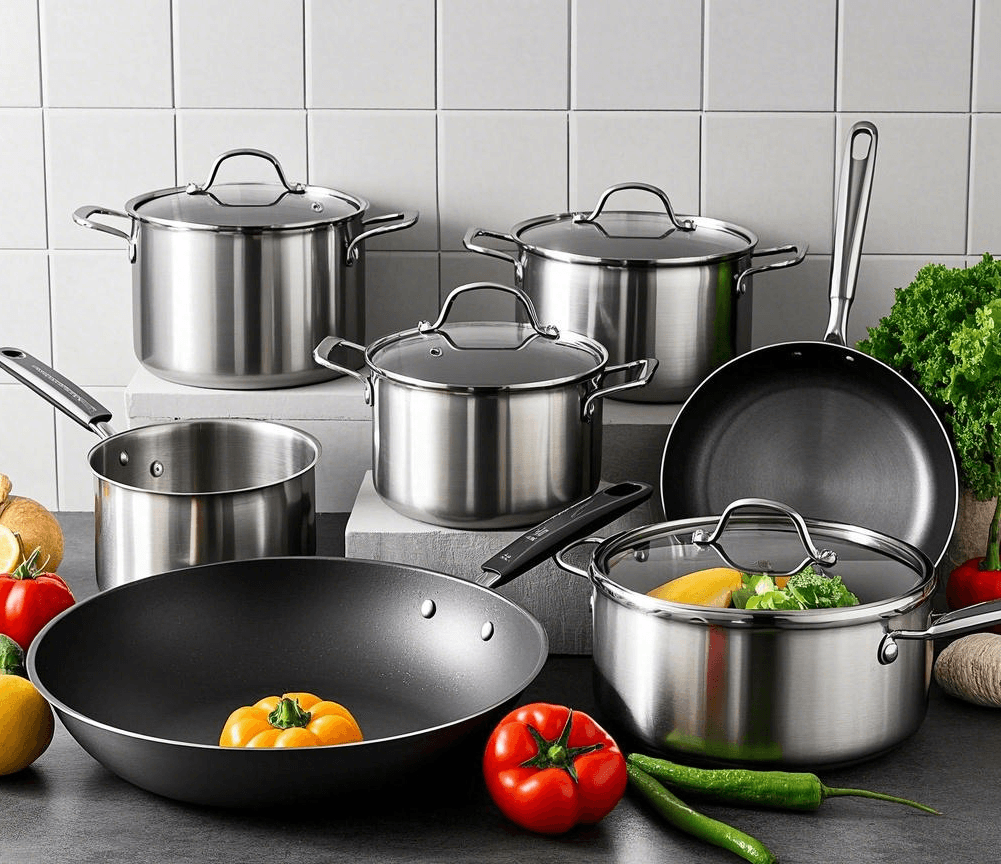
How Does Non-Reactivity Benefit the Versatility of Stainless Steel?
One of the greatest advantages of using stainless steel in cookware is its versatility. It can be used for a wide range of cooking tasks, from sautéing and frying to slow cooking and boiling, without the worry of chemical reactions with acidic ingredients.
• Versatile Use: Stainless steel cookware can be used for both acidic and non-acidic foods, making it an all-purpose option for both home and professional kitchens.
• Multi-Use Durability: The material’s non-reactivity means it’s ideal for preparing a variety of dishes, from sweet and savory sauces to acidic-based stews and soups.
Stainless steel is an invaluable material for cooks who want versatility and reliability in their cookware.
Claim: Why Stainless Steel’s Non-Reactivity Is Crucial for Cooking with Acidic Foods
The non-reactive nature of stainless steel ensures that acidic foods are cooked safely without altering their taste, texture, or nutritional value. This characteristic makes stainless steel the ideal choice for cooking dishes that rely on precise flavors and even cooking, without the risk of contamination or degradation.
Conclusion: The Safety and Flavor Benefits of Stainless Steel in Acidic Cooking
Stainless steel’s non-reactive properties provide key benefits when cooking with acidic foods, ensuring that they maintain their natural flavors, nutrients, and safety. With consistent heat distribution, no metallic taste, and long-term durability, stainless steel cookware is the preferred choice for preparing a wide variety of dishes, including those with acidic ingredients.
Whether you’re making a tangy tomato sauce, marinating meats in vinegar, or cooking lemon-based dishes, stainless steel offers a safe, reliable, and efficient solution to cooking with acidic foods.

